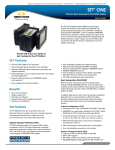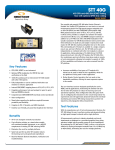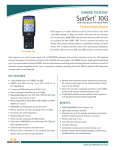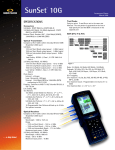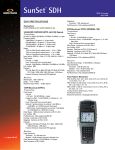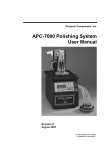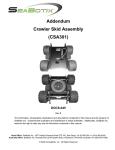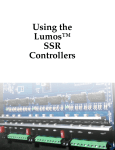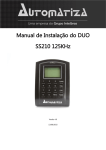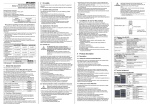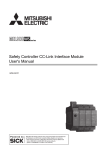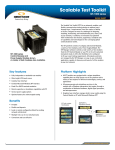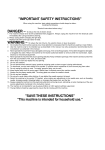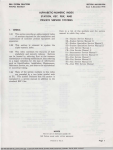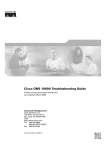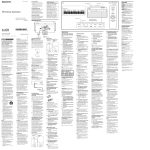Download STT ONE FINAL 1_06.indd
Transcript
SUNRISE TELECOM ® STT ONE OTN and Next-Generation SDH/SONET Testing Data Sheet The STT Optical Network Expert (ONE) is a powerful and versatile test module for the Scalable Test Toolkit (STT) for testing emerging technologies such as OTN (ITU-T G.709) and Next-Generation SDH/SONET, as well as traditional SDH/SONET, offering service providers a complete solution for today’s metro and core networks. By integrating OTN and EoS (VCAT, GFP, and LCAS) testing into a single, compact unit, the STT ONE module is extremely cost The STT ONE is part of a family of test modules for the STT Platform effective because it eliminates the need for multiple instruments. FEATURES • OTN, EoS, SDH, SONET in one instrument • Dual wavelength optical transmitters up to 2.66 Gbps • Advanced differential delay measurement, generation, and payload reassembly • Fully independent or can be combined with other test modules to enhance application • Ethernet traffic generation over SDH/SONET without extra equipment • Auto-configuration and tributary scan BENEFITS • All-in-one test solution • Single, compact unit • Extremely cost-effective • Eliminates the need for multiple instruments • Intuitive user-friendly GUI TEST FEATURES The STT ONE allows the user to perform routine and advanced testing on transport and access networks, legacy and next generation networks with a single test set. Its price to performance ratio makes this product ideal. Optical Transport Network (OTN) STT ONE provides Forward Error Correction (FEC), verifies conformance to ITU-T G.709 and a wide range of network performance standards, including end-to-end connectivity at OTU1 (2.66 Gbps) and OTU2 (10.7 Gbps) bit rates, and complete asynchronous/synchronous mapping of SDH/SONET client signals. • • • • • • • Conforms to ITU-T G.709 OTU1 (2.66 Gbps) and OTU2 (10.7 Gbps) interfaces Synchronous and Asynchronous mapping of SDH OTN/SDH, OTN/SONET muxtest Error performance analysis per ITU-T G.8201 and M.2401 OTU, ODU, OPU error injection & alarm generation OTU, ODU, and OPU bytes control and decode Next-Generation SDH/SONET With the growth of IP services and the increasing need to leverage existing SDH/SONET networks, service providers must routinely monitor and test NGN to ensure packet-based traffic is properly delivered across the network. STT ONE offers a complete solution for NGN. In additon, high and low order virtual concatenation capabilities help verify end-to-end connectivity. Its differential delay detection and generation functions help measure the delay in the existing network and stress the far end payload assembly circuitry by inserting a delay on each member. Virtual Concatenation (VCAT) • Conforms to ITU-T G.707, Telcordia GR-253 & ANSI T1.105-2001 • SDH/SONET error performance analysis per ITU-T G.821, G.828, G.829, M.2101, M.2110, M.2120, and Telcordia GR-253 • Virtual Concatenation Testing, VC-4-X-v, VC-3-X-v, VC-12-X-v, VC-11-X-v / STS-3-X-v, STS-1-X-v, VT1.5-X-v, VT2-X-v • Differential delay generation, measurement, and payload reassembly up to 256 ms • Path overhead bytes control and decode on each member • Error injection/alarm generation on each member www.sunrisetelecom.com Generic Framing Procedure (GFP) • Conforms to ITU-T G.7041 and ANSI T1.105-2001 • GFP-F support • GFP header control, error injection, and error detection Ethernet over SDH/SONET (EoS) • Ethernet frames generation via GFP-F • Layer 2, Layer 3 testing including VLAN and MPLS tags • Ethernet statistics Link Capacity Adjustment Scheme (LCAS) • Conforms to ITU-T G.7042 and ANSI T1.105-2001 • LCAS protocol emulation • Emulation of Source and Sink state machines (per member) • Generation and capture of member status information Traditional SDH/SONET • 52 Mbps to 2.5 Gbps testing • Mapping/demapping of contiguously concatenated payloads • SDH/SONET errors/alarms detection and generation • SDH/SONET overhead control and decode • Pointer monitoring and adjustment • APS timing measurement APPLICATIONS STT ONE allows the user to perform testing on transport and access networks, legacy and next generation networks with a single product. Out-of-Service Testing OTN/SDH/SONET NE ADM ADM STT • End-to-end error free transmission verification • Bringing into service measurements and error performance analysis conforming to ITU-T and Telcordia standards • SDH/SONET network routing verification EoS (VCAT, GFP, and LCAS) • End-to-end Ethernet over SDH/SONET tests • Verification of path connectivity • Stressing far end payload assembly structure by generating additional differential delay to each VCG member In-Service Testing STT ADM ADM STT • Through mode • In-service monitoring through protected monitoring points or optical splitters • Overhead bytes monitoring and decoding • Pointer monitoring • LCAS protocol monitoring • VCAT and LCAS interaction monitoring 2 STT ONE OTN • OTN/SDH, OTN/SONET Mux/demux testing • Asynchronous/synchronous mapping/demapping of SDH/SONET client signals into OTU1/2 NE STT EoS • Verification of proper mapping of Ethernet frames into GFP cells • Testing GFP behavior • Compatible with STT Ethernet module or SunSet MTT with -28 or -29 module Network Element Verification OTN/SDH/SONET NE • Error injection, alarm generation to STT verify NE remote indication • FEC error generation to verify NE Forward Error Correction capabilities • Frequency offset to stress clock recovery of NE • SDH/SONET Pointer Test Sequences generation to test NE response to problems with sync VCAT/GFP/LCAS • VCAT bandwidth availability verification • VCAT differential delay generation to stress NE payload assembly circuitry • LCAS state machines generation to verify NE response by increasing or decreasing bandwidth ABOUT STT PLATFORM STT NE Mux Test The Scalable Test Toolkit is an advanced, modular, and flexible testing solution that addresses Layer 1 through Layer 7 requirements, from fiber optics to Quality of Service. Designed to meet the challenges of designing, installing, maintaining, and troubleshooting core, metro, and access networks, the STT combines an innovative test platform with revolutionary test features, supporting a complete suite of capabilities and technologies for the converging global communications market. All STT modules are equipped with a unique standalone feature and can operate at 100% of their capabilities outside of the platform, maximizing test resources. • STT NAM. Traditional transport testing from 1.5 Mbps to 10 Gbps. Advanced features include tributary scan, pointer test sequences, APS/service disruption, VF, Pulse mask analysis, and DSn Jitter measurements. • STT FAM. Fiber physical layer testing. OTDR, optical power meter, laser source, ORL, and visual fault locator. • STT DTM. Measures Polarization Mode Dispersion (PMD) and Chromatic Dispersion (CD). • STT xWDM. OSA for the O, E, S, C and L bands. Channel drop and tunable laser for the C and L bands. • STT Ethernet. Ethernet testing for Layers 1, 2, and 3, from 10 Mbps to 10 GigE LAN/WAN and Fibre Channel. Advanced test features include MPLS, VLAN stacking, and packet capture and decode up to Layer 7. • STT MSA. Advanced protocol and service analysis, simulation, and troubleshooting of PSTN, VoIP, and 3G wireless. SPECIFICATIONS TEST INTERFACES OTN 10.7G Optical (OTU-2) Port/Connector Universal interface with FC/SC (STT-6953) SCAPC 9 degrees (STT-6955-SC9DEG) Mode: Single Line coding: NRZ Complies to ITU-T G.709 and ITU-T G.959.1 Transmitter Clock source Internal – Bit rate: 10.709225 Gbps ± 4.5 ppm – Frequency offset: ± 50 ppm with 1, 0.1, 0.01, or 0.001 ppm resolution Receive: Recovered from received signal External: Synchronization to external 2.048 Mbps or 2.048 MHz (SDH), 1.544 Mbps or 1.544 MHz (SONET) Output power range 1310 nm/1550 nm Short Reach: -4 to -1 dBm 1550 nm Intermediate Reach: -1 to +2 dBm 1550 nm Long Reach: 0 to +2 dBm Laser Safety: IEC825-1, Class 1, 21 CFR 1040.10 and 1040.11 Receiver Frequency recovery range: 10.709225 Gbps ± 50 ppm (OTN OTU-2) Complies to ITU-T G.709 and ITU-T G.959.1 Wavelength: 1290 to 1600 nm Input power range 1310 nm Short Reach, PIN detector: -15 to 0 dBm 1550 nm Short Reach, PIN detector: -15 to 0 dBm 1550 nm Intermediate/Long Reach, APD detector: -23 to -5 dBm Maximum input power: +7 dBm 2.66G Optical (OTU-1) Port/Connector Universal interface with FC/SC (STT-6953) SCAPC 9 degrees (STT-6955-SC9DEG) Mode: Single Line coding: NRZ Complies to ITU-T G.709 and ITU-T G.959.1 Transmitter Clock source Internal – Bit rate: 2.666057 Gbps ± 4.5 ppm – Frequency offset: ± 50 ppm with 1, 0.1, 0.01, or 0.001 ppm resolution Receive: Recovered from received signal External: Synchronization to external 2.048 Mbps or 2.048 MHz (SDH), 1.544 Mbps or 1.544 MHz (SONET) Output power range 1310 nm Short Reach: -10 to -3 dBm 1310 nm/1550 nm Long Reach: -2 to +3 dBm Laser Safety: IEC825-1, Class 1, 21 CFR 1040.10 and 1040.11 Receiver Frequency recovery range: 2.666057 Gbps ± 50 ppm Complies to ITU-T G.709 and ITU-T G.959.1 Wavelength: 1280 to 1580 nm Range: -27 to -9 dBm Maximum input power: -4 dBm Clock Output Connector: 50Ω SMA Signal: 1v peak to peak Frequency 10.7G: 669.324 MHz 2.66G: 166.628 MHz SDH/SONET 10G Optical (STM-64/OC-192) Port/Connector Universal interface with FC/SC (STT-6953) SCAPC 9 degrees (STT-6955-SC9DEG) Mode: Single and multi-mode compatible Line coding: NRZ Complies to ITU-T G.691 (SDH) and Telcordia GR-253 (SONET) Transmitter Clock source Internal – Bit rate: 9.95328 Gbps ± 4.5 ppm – Frequency offset: ± 50 ppm with 1, 0.1, 0.01, or 0.001 ppm resolution Receive: Recovered from received signal External: Synchronization to external 2.048 Mbps or 2.048 MHz (SDH), 1.544 Mbps or 1.544 MHz (SONET), 64k + 8k codirectional Output power range 1310 nm/1550 nm Short Reach: -4 to -1 dBm 1550 nm Intermediate Reach: -1 to +2 dBm 1550 nm Long Reach: 0 to +2 dBm Laser Safety: IEC825-1, Class 1, 21 CFR 1040.10 and 1040.11 Receiver Frequency recovery range: 9.95328 Gbps ± 50 ppm Complies to ITU-T G.691 and Telcordia GR-253 Wavelength: 1290 to 1600 nm Input power range 1310 nm/1550 nm Short Reach, PIN detector: -15 to 0 dBm 1550 nm Intermediate/Long Reach, APD detector: -23 to -5 dBm Maximum input power: +7 dBm www.sunrisetelecom.com 3 52/155/622M/2.5G Optical (STM-0/1/4/16 / OC-1/3/12/48) Port/Connector Universal interface with FC/SC (STT-6953) SCAPC 9 degrees (STT-6955-SC9DEG) Mode: Single and multi-mode compatible Line coding: NRZ Complies to ITU-T G.957 and Telcordia GR-253 Transmitter Clock source Internal – Bit rates 2.48832 Gbps ± 4.5 ppm 622.080 Mbps ± 4.5 ppm 155.520 Mbps ± 4.5 ppm 51.840 Mbps ± 4.5 ppm – Frequency offset: ± 50 ppm with 1, 0.1, 0.01, or 0.001 ppm resolution Receive: Recovered from received signal External: Synchronization to external 2.048 Mbps or 2.048 MHz (SDH), 1.544 Mbps or 1.544 MHz (SONET), 64k + 8k codirectional Output power range 1310 nm Short Reach: -10 to -3 dBm 1310 nm Long Reach: -2 to +3 dBm 1550 nm Long Reach: -2 to +3 dBm Laser Safety: IEC825-1, Class 1, 21 CFR 1040.10 and 1040.11 Receiver Frequency recovery range 2.48832 Gbps ± 50 ppm 622.080 Mbps ± 50 ppm 155.520 Mbps ± 50 ppm 51.840 Mbps ± 50 ppm Wavelength: 1280 to 1580 nm Range: -27 to -9 dBm Maximum input power: -4 dBm 155M Electrical (STM-1/STS-3) Port/Connector: 75Ω unbalanced BNC (f) Line coding: CMI Complies to ITU-T G.707 & Telcordia GR-253 (September 2000 issue) Transmitter Clock source Internal – Bit rate: 155.520 Mbps ± 4.5 ppm – Frequency offset: ± 50 ppm with 1, 0.1, 0.01, or 0.001 ppm resolution Receive: Recovered from received signal External: Synchronization to external 2.048 Mbps or 2.048 MHz (SDH), 1.544 Mbps or 1.544 MHz (SONET), 64k + 8k codirectional Pulse shape: Conforms to ITU-T G.703 Framing: Conforms to GR-253 and ITU-T G.707 Receiver Frequency recovery range: 155.520 Mbps ± 50 ppm Input sensitivity Terminate: 12.7 dB cable loss Monitor: 0 to -12.7 dB (20 dB resistive loss plus 12.7 dB cable loss) Jitter tolerance: Conforms to ITU-T G.825 4 STT ONE 52M Electrical (STM-0/STS-1) Port/Connector: 75Ω unbalanced BNC (f) Line coding: B3ZS Complies to Telcordia GR-253 (September 2000 issue) & ITU-T G.703 Transmitter Clock source Internal – Bit rate: 51.840 Mbps ± 4.5 ppm – Frequency offset: ± 50 ppm in with 1, 0.1, 0.01, or 0.001 ppm resolution Receive: Recovered from received signal External: Synchronization to external 2.048 Mbps or 2.048 MHz (SDH), 1.544 Mbps or 1.544 MHz (SONET), 64k + 8k codirectional Pulse shape: Conforms to GR-253 and ITU-R F.750-3 Framing: Conforms to GR-253 and ITU-T G.707 Receiver Frequency recovery range: 51.840 Mbps ± 50 ppm Input sensitivity: -26 dB from STX-1 (-20 dB plus 6 dB cable loss) Jitter tolerance: Conforms to ITU-T G.825 Clock Output Connector: 50Ω SMA Signal: 1v peak to peak Frequency 10G: 622.080 MHz 2.5G, 622M: 155.520 MHz 155M/52M: 19.44 MHz TEST FEATURES Application Modes Standards OTN, NGN SDH/SONET, Legacy SDH/PDH or SONET/T-Carrier Measurement Modes Out-of-service (BERT) or In-service (Live) Tx & Rx Coupled: Tx & Rx are coupled together & have the same configuration Independent: Tx & Rx may be configured independently Test Modes Single Point-to-Point Tx and Rx are set to the same rate Through Mode Operation (all interface rates) Line through Passes entire signal through with no manipulation of overhead or injection of errors or alarms Overhead can be monitored; alarms and errors measured Payload through Passes payload through Passes path overhead through SOH errors/alarms insertion/generation possible SOH overhead control possible (except pointers) OTN Mux Test The test pattern is generated on SDH/SONET or OTN Tx, and the BERT is measured on the OTN or SDH/SONET Rx. OTN Frame/Payloads Frame and mapping structure conforms to ITU-T G.709 Synchronous and asynchronous mapping of SDH/SONET payloads and PRBS test signals Test Patterns PRBS: 231-1, 223-1, 220-1, 215-1 Fixed: All 1s, All 0s, Alt 1010, 1-4 User: 10 programmable 16-bit user patterns. Pattern names up to 10 characters. Test pattern inversion Error Injection OTU-1/2: FAS (OA1, OA2), MFAS, SM-BIP-8, SM-BEI, correctable FEC errors, uncorrectable FEC errors ODU-1/2: PM-BIP-8, PM-BEI TCM1-6: BIP-8, BEI Burst: 1 to 9999 Rate: 1x10-9 to 2x10-3 (depending on configuration) Alarms LOS OTU-1/2: LOF, OOF, OOM, AIS, SM-TIM, SM-IAE, SM-BDI ODU-1/2: AIS, OCI, LCK, BDI, PM-TIM, PM-BDI OPU: PLM TCM1-6: OCI, AIS, LCK, TIM, BDI, IAE, LTC Error performance analysis: ITU-T G.8201, M.2401 Overhead Features Overhead Monitor Hex display of all bytes (OTU, ODU, and OPU) Text decode of all applicable bytes – TTI [SM (OTU), PM (ODU), TCM1-6], FTFL, APS/PCC, PSI – Conforms to ITU-T G.709 Overhead Programming Hex input for all bytes except framing (FAS and MFAS), parity (BIP8, BEI) and justification (JC) Trail Trace Identifier (TTI) Generation – SM (OTU), PM (ODU), TCM1-6: SAPI/DAPI 16 bytes E.164 ASCII sequence – Operation bytes: 32 bytes HEX or E.164 ASCII sequence Automatic Protection Switching (APS)/Protection Communcation Channel (PCC) bytes control & decode per ITU-T G.709 and G.873 Fault Type Fault Locator (FTFL) control and decode. Forward and backward field structure per ITU-T G.709 Payload Structure Identifier – Payload type generation/decode: Hex mode or text mode – Conforms to ITU-T G.709, PT decode requires locking to MF #1 Overhead Sequence Generation Bytes: TTI (SM, PM, TCM1-6) (1 to 64 bytes), GC0 (2 bytes), GCC1 (2 bytes), GCC2 (2 bytes), APS/PCC (4 bytes), or any single overhead byte Generates up to 256 elements, where each element (value) can be transmitted in up to 65536 consecutive frames Overhead Sequence Capture OA1/OA2 (6 bytes), TTI (SM, PM, TCM1-6) (1 to 64 bytes), GC0 (2 bytes), GCC1 (2 bytes), GCC2 (2 bytes), APS/PCC (4 bytes), or any single overhead byte Captures up to 4096 elements, where each element (value) can be detected in up to 65536 consecutive frames GCC0, GCC1, or GCC2 Drop and Insert GCC0, GCC1, or GCC2 BER Testing Alarm Generation LOS OTU-1/2: LOF, OOF, OOM, AIS, SM-TIM, SM-IAE, SM-BDI ODU-1/2: AIS, OCI, LCK, PM-TIM, PM-BDI OPU-1/2: PLM TCM1-6: OCI, AIS, LCK, TIM, BDI, IAE, LTC SDH Measurements Test Patterns Errors OTU-1/2: FAS (OA1, OA2), MFAS, SM-BIP-8, SM-BEI, correctable FEC errors, uncorrectable FEC errors ODU-1/2: PM-BIP-8, PM-BEI TCM1-6: BIP-8, BEI Payload Bit Errors Payloads VC4-64c Bulk, VC4-16c Bulk, VC4-4c Bulk, VC4 Bulk, VC3 Bulk, VC12 Bulk, VC11 Bulk PRBS: 231-1 (2.5/10G), 223-1, 220-1, 215-1, 211-1, 29-1 Fixed: All 1s, All 0s, Alt 1010, 1-4 User: 10 programmable 16-bit user patterns. Pattern names up to 10 characters. Test pattern inversion www.sunrisetelecom.com 5 Error Injection Code (52Me, 155Me), Bit, FAS (except at 10 Gbps), B1, B2, B3, LPBIP, MS-REI, HP-REI, LP-REI Burst: 1 to 8000 Rate: 1x10-9 to 2x10-3 (depending on configuration) Alarm Generation RS: LOS, LOF, RS-TIM AU: AU-LOP, AU-AIS MS: MS-AIS, MS-RDI HP: HP-AIS, HP-UNEQ, HP-TIM, HP-RDI, HP-ERDI (Payload, Server, Connectivity) TU: TU-LOP, TU-AIS, TU-LOM LP: LP-UNEQ, LP-TIM, LP-RDI, LP-ERDI (Payload, Server, Connectivity) Measurements Errors: Bit, B1, B2, B3, BIP-2, MS REI, HP/LP REI Alarms: LOS, LOF, OOF, RS-TIM, MS-AIS, MS-RDI, AU-AIS, AULOP, HP-AIS, HP-PLM, HP-ERDI (Payload, Server, Connectivity), HP-TIM, HP-UNEQ, TU-LOM, TU AIS, TU-LOP, LP-PLM, LP-ERDI (Payload, Server, Connectivity), LP-TIM, LP-UNEQ Error performance analysis: ITU-T G.821, G.826, G.828, G.829, M.2101, M.2110, M.2120 Overhead Features Overhead Monitor Hex display of all bytes (RS, MS, HP, and LP) Text decode of all applicable bytes (K1/K2, S1, C2, etc.) Overhead Programming Hex input for all bytes except parity (B1/B2/B3), pointers (H1-H3, V1-V3), and undefined bytes Text encoding of all applicable bytes (K1/K2, S1, C2, etc.) Trace Generation J0 Section trace: 1 byte, 16 bytes E.164 ASCII sequence + CRC-7 or 64 bytes E.164 ASCII sequence J1/J2 Path trace: 16 bytes E.164 ASCII sequence + CRC-7 or 64 bytes E.164 ASCII sequence Selection: Default, user, or through Pointer Monitor AU (bytes H1 and H2), TU (bytes V1 and V2) Instantaneous pointer value display Loss of pointer seconds Total justification counts Positive justification counts Negative justification counts NDF seconds Pointer Adjustment Programming of AU and TU pointer value, New Data Flag (NDF), and SS bits Pointer increase or decrease Overhead Sequence Generation Bytes: A1/A2 (6 bytes), J0/J1/J2 (1, 16, and 64 bytes), D1-D3 (3 bytes), D4-D12 (9 bytes), K1/K2 (2 bytes), or any single overhead byte Generates up to 16 elements, where each element (value) can be transmitted in up to 65536 consecutive frames Overhead Sequence Capture Capture: A1/A2 (6 bytes), J0/J1/J2 (1, 16, and 64 bytes), D1-D3 (3 bytes), D4-D12 (9 bytes), K1/K2 (2 bytes), or any single overhead byte 6 STT ONE Each new value is captured with a timestamp (absolute or elapsed) and duration (in ms or frames) Trigger: Manual or user-defined value Resolution: 125 ms (1 frame) Captures up to 4096 elements, where each element (value) can be detected in up to 65536 consecutive frames Data Communications Channel (DCC) DCC BER testing: PRBS on D1-D3 or D4-D12 bytes (user-selectable) with G.821 analysis DCC Drop/Insert Pointer Test Sequences Specifications: ITU-T G.783 Sequences: Single, burst, phase transient burst, periodic, 87-3, 26-1, opposite, and custom Movement: Increase, decrease, increase + decrease Anomalies: Added, cancel, and none Frequency offset: Positive, negative, and none Sequence timing: Initialization, cool down, and measurement Automatic Protection Switch Time Measurement Resolution: 125 microseconds (1 frame) Sensors: LOS, LOF, MS-AIS, MS-RDI, MS-REI, AU-AIS, HP-RDI, HPREI, LP-RDI, LP-BIP, LP-REI, TU-AIS, B1, B2, B3 1 ms resolution with Pass/Fail indication Programmable switch time and gate time SONET Payloads STS-192c SPE, STS-48c SPE, STS-12c SPE, STS-3c SPE, STS-1 SPE, VT2, VT1.5 Test Patterns Applies to payloads of STS-1 SPE and above (concatenated rates) PRBS: 231-1 (2.5/10G), 223-1, 220-1, 215-1, 211-1, 29-1 Fixed: All 1s, All 0s, Alt 1010, 1-4 User: 10 programmable 16-bit user patterns. Pattern names up to 10 characters. Test pattern inversion Error Injection Code (STS-1e, STS-3e), Bit, Frame (except at 10 Gbps), B1 (CV-S), B2 (CV-L), B3 (CV-P), BIP-V, REI-L, REI-P, REI-V Burst: 1 to 8000 Rate: 1x10-9 to 2x10-3 (depending on configuration) Alarm Generation Section: LOS, LOF, TIM-S Line: AIS-L, RDI-L Path: LOP-P, AIS-P, UNEQ-P, TIM-P, RDI-P, ERDI-P VT-Path: LOP-V, AIS-V, UNEQ-V, TIM-V, RDI-V, ERDI-V Measurements Errors: B1 (CV-S), B2 (CV-L), B3 (CV-P), BIP-V (CV-V), REI-V, REI-L, REI-P Alarms LOS, LOF, TIM-S/P/V, AIS-L/P/V, RDI-L/P/V, ERDI-P/V, LOP-P/V, PLM-P/V, UNEQ-P/V, TIM-P (optional) Failure indications for all alarms Error performance analysis: Telcordia GR-253-CORE Section: SEFS-S, CV-S (B1), ES-S, SES-S Line Near End: CV-L (B2), ES-L, SES-L, UAS-L, FC-L Line Far End: CV-LFE (REI-L), ES-LFE, SES-LFE, UAS-LFE, FC-LFE Path Near End: CV-P (B3), ES-P, SES-P, UAS-P, FC-P Path Far End: CV-PFE (REI-P), ES-PFE, SES-PFE, UAS-PFE, FC-PFE VT Path Near End: CV-V (BIP-2), ES-V, SES-V, UAS-V, FC-V VT Path Far End: CV-VFE (REI-V), ES-VFE, SES-VFE, UAS-VFE, FC-VFE Pointers: PPJC-P/VDet, NPJC-P/VDet, PPJC-P/VGen, NPJC-P/VGen, PJCDiff-P/V, PJCS-P/VDet, PJCS-P/VGen, plus Pointer Value and NDF-P/V counter Overhead Features Overhead Monitor Hex display of all bytes (Section, Line, Path, and VT Path) Text decode of all applicable bytes (K1/K2, S1, C2, etc.) Overhead Programming Hex input for all bytes except parity (B1/B2/B3), pointers (H1-H3, V1-V3), and undefined bytes Text encoding of all applicable bytes (K1/K2, S1, C2, etc.) Trace Generation J0 Section trace: 1 byte, 16 bytes E.164 ASCII sequence + CRC-7 or 64 bytes E.164 ASCII sequence J1/J2 Path trace: 16 bytes E.164 ASCII sequence + CRC-7 or 64 bytes E.164 ASCII sequence Selection: Default, user, or through Pointer Monitor STS (bytes H1 and H2), VT (bytes V1 and V2) Instantaneous pointer value display Loss of pointer seconds Total justification counts Positive justification counts Negative justification counts NDF seconds Pointer Adjustment Programming of STS and VT pointer value, New Data Flag (NDF), and SS bits Pointer increase or decrease Overhead Sequence Generation Bytes: A1/A2 (6 bytes), J0/J1/J2 (1, 16 and 64 bytes), D1-D3 (3 bytes), D4-D12 (9 bytes), K1/K2 (2 bytes), or any single overhead byte Generates up to 16 elements, where each element (value) can be transmitted in up to 65536 consecutive frames Overhead Sequence Capture Capture: A1/A2 (6 bytes), J0/J1/J2 (1, 16, and 64 bytes), D1-D3 (3 bytes), D4-D12 (9 bytes), K1/K2 (2 bytes), or any single overhead byte Each new value is captured with a timestamp (absolute or elapsed) and duration (in ms or frames) Trigger: Manual or user-defined value Resolution: 125 ms (1 frame) Captures up to 4096 elements, where each element (value) can be detected in up to 65536 consecutive frames Data Communications Channel (DCC) DCC BER testing: PRBS on D1-D3 or D4-D12 bytes (user-selectable) with bit error performance analysis DCC Drop/Insert Pointer Test Sequences Specifications: ANSI T1.105.03, Telcordia GR-253 Sequences: Single, burst, phase transient burst, periodic, 87-3, 26-1, opposite, and custom Movement: Increase, decrease, increase + decrease Anomalies: Added, cancel, and none Frequency offset: Positive, negative, and none Sequence timing: Initialization, cool down, and measurement Automatic Protection Switch Time Measurement Resolution: 125 microseconds (1 frame) Sensors: LOS, LOF, AIS-L, AIS-V, RDI-L, AIS-P, REI-L, RDI-P, RDI-V, REI-P, REI-V, BIP-V, B1, B2, B3 1 ms resolution with Pass/Fail indication Programmable switch time and gate time Common to OTN, SDH/SONET Measurements Optical power level measurement Accuracy: ± 1 dBm Wavelength: 1310 nm or 1550 nm Optical saturation indication Frequency measurements: Current frequency, max frequency, min frequency Clock slip measurements: Clock slips, frame slips, positive wander, negative wander, plus moving bar graph of slip count when reference clock set to External Histogram analysis Errors/Alarms/Pointer graphic display in real-time Stores current results with 1-second resolution for the last 60 minutes, 1-minute resolution for the last 72 hrs, and 15-minute resolution for the last 60 days Compare two parameters to visually detect correlation Propagation delay Service disruption measurement Measurement setting Continuous measurement Programmable start time and duration Elapsed time, remaining time display Measurement result management Save As: Save measurement results to the hard drive (or other removable media) Open: Open a previously saved measurement result Print: Print a measurement result report Export: Export a measurement result report file with comma separated values (which can be read by either a text editor, word processor, or spreadsheet program) or external markup language format (which can be converted into pdf) Next-Generation SDH/SONET (STT-6200) Virtual Concatenation (VCAT) SDH Virtual Concatenation per ITU-T G.707 High Order Paths: VC-4-X-v, X=1 to 16, VC-3-X-v, X=1 to 48 Low Order Paths: VC-11-X-v, VC-12-X-v, X=1 to 64 (from 12 different AU3 or 4 different AU4) www.sunrisetelecom.com 7 SONET Virtual Concatenation per ANSI T1.105-2001 High Order Paths: STS-1-X-v, X=1 to 48, STS-3-X-v, X=1 to 16 Virtual Tributary Paths: VT1.5-X-v, VT-2-X-v, X=1 to 64 (from 12 different STS-1s or 4 different STS-3s) Measurements/Generation Differential Delay Measurement & Generation (per group member) Individual and group wide measurement Measurement and generation range: 256 ms VCAT reassembly range: Up to 256 ms Errors (per group member) SDH: Bit, B3, HP-REI, LP-BIP, LP-REI SONET: Bit, B3 (CV-P), BIP-V, REI-P, REI-V Alarms (per group member) SDH: AU-AIS, AU-LOP, HP-AIS, HP-RDI, HP-ERDI (Payload, Server, Connectivity), HP-UNEQ, HP-TIM, TU-LOM, TU-AIS, TU-LOP, LPRDI, LP-ERDI (Payload, Server, Connectivity), LP-UNEQ, LP-TIM SONET: TIM-P/V, AIS-P/V, RDI-P/V, ERDI-P/V (Payload, Server, Connectivity), LOP-P/V, UNEQ-P/V, H4 LOM Error performance analysis (per group member) SDH: Per ITU-T G.821, G.826, G.828, M.2101, M.2120 SONET: Per Telcordia GR-253 Generic Framing Procedure (GFP) Per ITU-T G.7041, G.707, and ANSI T1.105.02-2001 Traffic generation; Ethernet frames Frame size: Up to 65539 bytes Bandwidth dependent on Virtual Concatenation GFP Payload type header control: PTI, PFI, EXI (linear and null), CID (linear only), and UPI GFP-F (Frame) frames generation Measurements: Idle frames, Total frames, Total octets, Client frames, Client frames with FCS, Client management frames, Extension header OK frames, Type header OK frames, Null extension frames, Linear frames, Ring frames, Ethernet mapped frames Errors (GFP-F): Correctable cHEC errors, uncorrectable cHEC errors, correctable tHEC, uncorrectable tHEC, correctable eHEC, uncorrectable eHEC, payload FCS, invalid payload Alarms: GFP Synchronization failure LCAS Protocol Emulation Emulation of Source and Sink state machines (per group member) Direct commands – Source: Add/Remove member, Add/Remove members – Sink: Add/Remove member, Add/Remove members Overwrite received member status (source): OK, FAIL, AUTO Overwrite generated member status (sink): FAIL, AUTO Force resequence acknowledge: RX RS-Ack (source), TX RS-Ack (sink) Force member status alarm (sink): MSU Generation and Capture of Member Status Information Transmitted (source) and received (sink) sequence numbers Received (source) and transmitted (sink) resequence acknowledge Source machine state decode: IDLE, ADD, NORM, DNU (Do Not Use), REMOVE Sink machine state decode: IDLE, FAIL, OK Source transmitted control word: ADD, NORM, EOS, IDLE, DNU Sink received control word: ADD, NORM (normal transmission), EOS (End of Sequence indication and normal transmission), IDLE, DNU, FIXED (non-LCAS mode) Sink received alarms: LOS (Loss of Sequence), MSU (Member Status Unavailable), FOP CRC (Failure of Protocol Excessive CRC errors) Sink received errors: Failure of Protocol Excessive errors (CRC failure) LCAS Errors Generation and Detection Source (Tx): LCAS-CRC per member Error injection: Single Ethernet over SDH/SONET (EoS) Test Layer Layer 2: MAC Layer 3: MAC + IP User-defined IP Header TOS, ID, Fragmentation, TTL, Protocol VLAN VLAN ID: 0 to 4095 Priority: 0 to 7 Stacked VLAN: Up to 3 VLAN tags MPLS Up to 3 MPLS tags Unicast or Multicast Frame Length* 60 to 12,000 bytes Fixed Gaussian distribution Multiple gaussians Uniform distribution * Minimum frame lengths apply to Layer 2 traffic. Layer 3 traffic or the addition of VLAN or MPLS tags will affect this value. Traffic Generation Link Capacity Adjustment Scheme (LCAS) Per ITU-T G.7042, G.707, and ANSI T1.105.02-2001 LCAS mode: Enable, disable H4, K4/Z7 monitoring: Control packets 8 STT ONE Traffic groups: 2 (each group is assigned a frame length & traffic shape) Traffic shapes: Constant, ramp, burst, short burst, manual burst Bandwidth: 0.01% to 100.00% Traffic streams: Single stream with unique MAC, VLAN, MPLS, IP address, and IP Throughput Measurements ORDERING INFORMATION Aggregate Defects Data errors: IP checksum, FCS/CRC, Lost Frames Control Module Tx/Rx Traffic Statistics General: Total Frames, Total Octets Allocated Line Rate, Real Line Rate and Data Rate Frame rate: Current, Minimum, Maximum, Average Utilization: Current, Minimum, Maximum, Average Frame types: Unicast, Multicast, Broadcast, Non Test Traffic (Rx only), Flow Control, Bad Frames (Rx only) Frame size counters: Runt/Undersized, 64, 65-127, 128-255, 256511, 512-1023, 1024-1518, Jumbo/Oversized Power Module Per Stream Statistics Data errors: IP checksum, Lost Frames Tx/Rx statistics: Total Frames, Total Octets PRODUCT DESCRIPTION Configuration Auto-configuration: Automatically determines rate framing, payload structure, and test pattern Configures Tx to match the receiver Save/View/Load configurations: Save and reload configuration profiles Upgrades: SW upgradable via CD-ROM, PCMCIA memory card, or USB memory device Power consumption: 105 watts (powered from STT Platform Power Module or SA427) Environmental Operating temperature: 32 to 104°F (0 to 40°C) Storage temperature: -4 to 158°F (-20 to 70°C) Humidity: 5% to 90% noncondensing Dimensions Size: 12.6 x 8.7 x 5.9 in (320 x 220 x 150 mm) Weight: 8.5 lb (3.86 kg) STT-1001 STT-1501 STT-1505A STT-1521 STT-1525 STT Control Module [STT Control and Display Module. Windows XP Professional SP2 OS. Includes STT Manager Software (STT1000-SW1), STT User’s Manual (SA920), Qty 2 Stylus (SA142), STT bus bridge case (SA144), Small Accessory Storage case (SA149), and three-year warranty on chassis. One-year warranty on battery and accessories. Requires STT Power Module and Test Module(s)] Power Module, AC. 216 Watt maximum output. Power Module, AC and Battery. 120 Watt maximum output. Power Module, AC. 340 Watt maximum output. Power Module, AC and Battery. 150 Watt maximum output. Test Module STT-6001 STT-ONE Module. SDH/SONET analysis at transmission rates from 52 Mbps up to 2.5 Gbps. Support 52 Mbps and 155 Mbps electrical interfaces, BNC connectors. Support 52 Mbps, 155 Mbps, 622 Mbps, and 2.5 Gbps optical interfaces. Software upgradeable to OTU1 (2.66 Gbps). [Includes optical attenuator, FCPC, -10 dB (SA521) or SCPC, -10 dB (SA531), Optical Network Expert Module Software (STT-6000-SW1), Optical Network Expert Module User’s Manual (SA925), and Certificate of Calibration] 2.5/2.66G Optics Options STT-6010 STT-6011 STT-6012 STT-6014 STT-6022 STT-6023 STT-6024 1310 nm Short Reach Tx/Rx. For rates of 2.66 Gbps, 2.5 Gbps, 622 Mbps, 155 Mbps, and 52 Mbps. 1310 nm Intermediate Reach Tx/Rx. For rates of 2.66 Gbps, 2.5 Gbps, 622 Mbps, 155 Mbps, and 52 Mbps. 1310 nm Long Reach Tx/Rx. For rates of 2.66 Gbps, 2.5 Gbps, 622 Mbps, 155 Mbps, and 52 Mbps. 1550 nm Long Reach Tx/Rx. For rates of 2.66 Gbps, 2.5 Gbps, 622 Mbps, 155 Mbps, and 52 Mbps. Dual wavelength. 1310 nm Short Reach Tx, 1550 nm Long Reach Tx, Wideband Long Reach Rx. For rates of 2.66 Gbps, 2.5 Gbps, 622 Mbps, 155 Mbps, and 52 Mbps. Dual wavelength. 1310 nm Intermediate Reach Tx, 1550 nm Long Reach Tx, Wideband Long Reach Rx. For rates of 2.66 Gbps, 2.5 Gbps, 622 Mbps, 155 Mbps, and 52 Mbps. Dual wavelength. 1310 nm Long Reach Tx, 1550 nm Long Reach Tx, Wideband Long Reach Rx. For rates of 2.66 Gbps, 2.5 Gbps, 622 Mbps, 155 Mbps, and, 52 Mbps. 10/10.7G Optics STT-6100 STT-6101 SDH/SONET analysis at 10 Gbps transmission rate. 1550 nm 20 km Tx. Wideband standard sensitivity PIN detector Rx. Software upgradeable to OTU2 (10.7 Gbps). [Includes Optical Attenuator, FCPC, -10 dB (SA521) or SCPC, -10 dB (SA531)]. SDH/SONET analysis at 10 Gbps transmission rate. 1550 nm 40 km Tx. Wideband high sensitivity APD detector Rx. Software upgradeable to OTU2 (10.7 Gbps). [Includes Optical Attenuator, FCPC, -10 dB (SA521) or SCPC, -10 dB (SA531)]. www.sunrisetelecom.com 9 STT-6102 STT-6103 SDH/SONET analysis at 10 Gbps transmission rate. 1550 nm 80 km Tx. Wideband standard sensitivity APD detector Rx. Software upgradeable to OTU2 (10.7 Gbps). [Includes Optical Attenuator, FCPC, -10 dB (SA521) or SCPC, -10 dB (SA531)]. SDH/SONET analysis at 10 Gbps transmission rate. 1310 nm 24 km Tx. Wideband standard sensitivity PIN detector Rx. Software upgradeable to OTU2 (10.7 Gbps). [Includes Optical Attenuator, FCPC, -10 dB (SA521) or SCPC, -10 dB (SA531)]. Optical Connectors STT-6951 STT-6952 STT-6953 STT-6250 EoS Hardware option (VCAT, GFP, LCAS Testing for all SDH/SONET rates) PDH/T-Carrier Hardware option Primary port for bit rates from 1.5/2 Mbps to 140 Mbps. Bantam connector for balanced 1.5M/2M. BNC connector for 2 Mbps, 8 Mbps, 34 Mbps, 45 Mbps, and 140 Mbps. Auxiliary port: unbalanced BNC for 2 Mbps and 34 Mbps. SS106 SS108 SS109 SS122B SS220 SS225 SS227 SS303 SS315 SA155-UK SA155-EU SA427 SA620 SA622 Software Option Cable, single bantam (m) 120Ω to 800 DSx plug (m) 120Ω, 6’ Cable, single bantam (m) 120Ω to two heavy test clips 120Ω, 6’ Cable, single bantam (m) 120Ω to single bantam (m) 120Ω, 6’ Cable, single bantam (m) 120Ω to single 310 (m) 120Ω, 6 ‘ Cable, single bantam (m) 120Ω to alligator clips 120Ω, 6’ Null Modem Adapter. DB-9 (f) to DB-9 (f) with Full Handshaking Conversion Cable, BNC (m) 75Ω to 3-pin banana CF (m) 120Ω, 6’ Cable, BNC (m) 75Ω to BNC (m) 75Ω, 6’ Conversion Cable, single bantam (m) 120Ω to BNC (m) 75Ω, 6’ Conversion Cable, BNC (m) 75Ω to 1.6/5.6 mm (m) 75Ω, 6 ‘ Cable, bantam (m) 120Ω to 3-pin banana CF (m) 120Ω, 6 ‘ Conversion Cable, BNC (m) 75Ω to probe clips 120Ω, 6’ Cable, BNC (m) 75Ω to WECO 440A (m) 75Ω, 6’ Cable, BNC (m) 75Ω to WECO 358A (Large) (m) 75Ω, 6’ Other Accessories SA155-NA FC adapter for Universal Optical connector SC adapter for Universal Optical connector LC adapter for Universal Optical connector ST adapter for Universal Optical connector DIN adapter for Universal Optical connector STT-6300 SA302 SS211 SS212 Universal Connector Adapters SA527 SA528 SA529 SA530 SA532 SA301 SS210 FCUPC connectors for all optical interfaces SCUPC connectors for all optical interfaces Universal optical base connectors. UPC termination. Hardware Options STT-6200 Electrical Cables and Adapters 3-prong Power Cord for use in United Kingdom 2-prong Power Cord plus ground for use in Europe (except UK) 3-prong Power Cord for use in Latin America, North America, and Asia Standalone Accessory Package for the STT Modules, 130 Watt Semi-rigid Carrying Case with wheels and telescoping handle Hard Carrying Case with wheels, STT OTN Testing. Adds OTN testing to STT ONE. [Requires STT-601X/602X for OTU1 and STT-61XX for OTU2] Optical Accessories SS427 SA501 SA502 SA503 SA504 SA508 SA509 SA511 SA512 SA513 SA514 SA519 SA520 SA521 SA523 SA524 SA531 SA541 SA545 SA551 SA555 Telephone Handset Optical Patch Cord, SMF, FCUPC to FCUPC, 6’ Optical Patch Cord, SMF, FCUPC to SCUPC, 6’ Optical Patch Cord, SMF, FCUPC to STUPC, 6’ Optical Patch Cord, SMF, FCUPC to FCAPC, 6’ Optical Patch Cord, SMF, LCUPC to SCUPC, 6’ Optical Patch Cord, SMF, LCUPC to FCUPC, 6’ Optical Patch Cord, SMF, SCUPC to SCUPC, 6’ Optical Patch Cord, SMF, SCUPC to STUPC, 6’ Optical Jumper, SMF, FCUPC to FCUPC, 1’ Optical Jumper, SMF, SCUPC to SCUPC, 1’ Optical Patch Cord, SMF, SCUPC to FCAPC, 6’ Optical Patch Cord, SMF, FCAPC to FCAPC, 6’ Optical Attenuator, FC-PC, -10 dB Optical Connector Adapter, SCUPC to FCUPC [Changes an FC (f) appearance to an SC (f) appearance] Optical Connector Adapter, FCUPC to SCUPC [Changes an SC (f) appearance to an FC (f) appearance] Optical Attenuator, SC-PC, -10 dB Optical Splitter, FC-PC, 90/10 Optical Splitter, FC-PC, 50/50 Optical Splitter, SC-PC, 90/10 Optical Splitter, SC-PC, 50/50 For more information or a directory of sales offices: [email protected] www.sunrisetelecom.com © 2006 Sunrise Telecom Incorporated. All rights reserved. Specifications subject to change without notice. All product and company names are trademarks of their respective corporations. Sunrise Telecom San Jose, Modena, and Taiwan facilities are ISO 9001 certified. Do not reproduce, redistribute, or repost without written permission from Sunrise Telecom. REV.A00 January 2006










